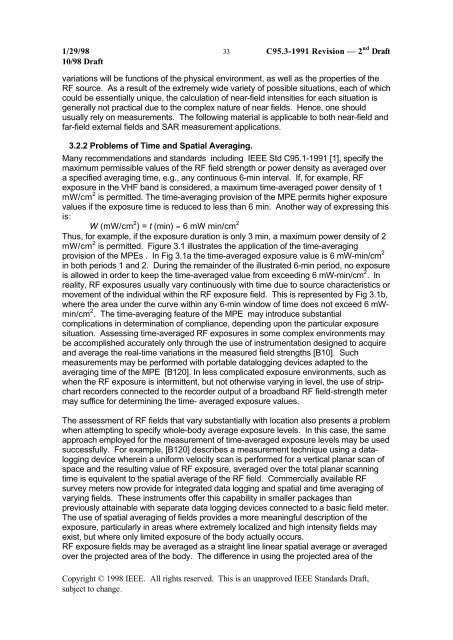DRAFT Recommended Practice for Measurements and ...
DRAFT Recommended Practice for Measurements and ...
DRAFT Recommended Practice for Measurements and ...
Create successful ePaper yourself
Turn your PDF publications into a flip-book with our unique Google optimized e-Paper software.
1/29/98 33 C95.3-1991 Revision — 2 nd Draft<br />
10/98 Draft<br />
variations will be functions of the physical environment, as well as the properties of the<br />
RF source. As a result of the extremely wide variety of possible situations, each of which<br />
could be essentially unique, the calculation of near-field intensities <strong>for</strong> each situation is<br />
generally not practical due to the complex nature of near fields. Hence, one should<br />
usually rely on measurements. The following material is applicable to both near-field <strong>and</strong><br />
far-field external fields <strong>and</strong> SAR measurement applications.<br />
3.2.2 Problems of Time <strong>and</strong> Spatial Averaging.<br />
Many recommendations <strong>and</strong> st<strong>and</strong>ards including IEEE Std C95.1-1991 [1], specify the<br />
maximum permissible values of the RF field strength or power density as averaged over<br />
a specified averaging time, e.g., any continuous 6-min interval. If, <strong>for</strong> example, RF<br />
exposure in the VHF b<strong>and</strong> is considered, a maximum time-averaged power density of 1<br />
mW/cm 2 is permitted. The time-averaging provision of the MPE permits higher exposure<br />
values if the exposure time is reduced to less than 6 min. Another way of expressing this<br />
is:<br />
W (mW/cm 2 ) = t (min) = 6 mW min/cm 2<br />
Thus, <strong>for</strong> example, if the exposure duration is only 3 min, a maximum power density of 2<br />
mW/cm 2 is permitted. Figure 3.1 illustrates the application of the time-averaging<br />
provision of the MPEs . In Fig 3.1a the time-averaged exposure value is 6 mW-min/cm 2<br />
in both periods 1 <strong>and</strong> 2. During the remainder of the illustrated 6-min period, no exposure<br />
is allowed in order to keep the time-averaged value from exceeding 6 mW-min/cm 2 . In<br />
reality, RF exposures usually vary continuously with time due to source characteristics or<br />
movement of the individual within the RF exposure field. This is represented by Fig 3.1b,<br />
where the area under the curve within any 6-min window of time does not exceed 6 mWmin/cm<br />
2 . The time-averaging feature of the MPE may introduce substantial<br />
complications in determination of compliance, depending upon the particular exposure<br />
situation. Assessing time-averaged RF exposures in some complex environments may<br />
be accomplished accurately only through the use of instrumentation designed to acquire<br />
<strong>and</strong> average the real-time variations in the measured field strengths [B10]. Such<br />
measurements may be per<strong>for</strong>med with portable datalogging devices adapted to the<br />
averaging time of the MPE [B120]. In less complicated exposure environments, such as<br />
when the RF exposure is intermittent, but not otherwise varying in level, the use of stripchart<br />
recorders connected to the recorder output of a broadb<strong>and</strong> RF field-strength meter<br />
may suffice <strong>for</strong> determining the time- averaged exposure values.<br />
The assessment of RF fields that vary substantially with location also presents a problem<br />
when attempting to specify whole-body average exposure levels. In this case, the same<br />
approach employed <strong>for</strong> the measurement of time-averaged exposure levels may be used<br />
successfully. For example, [B120] describes a measurement technique using a datalogging<br />
device wherein a uni<strong>for</strong>m velocity scan is per<strong>for</strong>med <strong>for</strong> a vertical planar scan of<br />
space <strong>and</strong> the resulting value of RF exposure, averaged over the total planar scanning<br />
time is equivalent to the spatial average of the RF field. Commercially available RF<br />
survey meters now provide <strong>for</strong> integrated data logging <strong>and</strong> spatial <strong>and</strong> time averaging of<br />
varying fields. These instruments offer this capability in smaller packages than<br />
previously attainable with separate data logging devices connected to a basic field meter.<br />
The use of spatial averaging of fields provides a more meaningful description of the<br />
exposure, particularly in areas where extremely localized <strong>and</strong> high intensity fields may<br />
exist, but where only limited exposure of the body actually occurs.<br />
RF exposure fields may be averaged as a straight line linear spatial average or averaged<br />
over the projected area of the body. The difference in using the projected area of the<br />
Copyright © 1998 IEEE. All rights reserved. This is an unapproved IEEE St<strong>and</strong>ards Draft,<br />
subject to change.
















